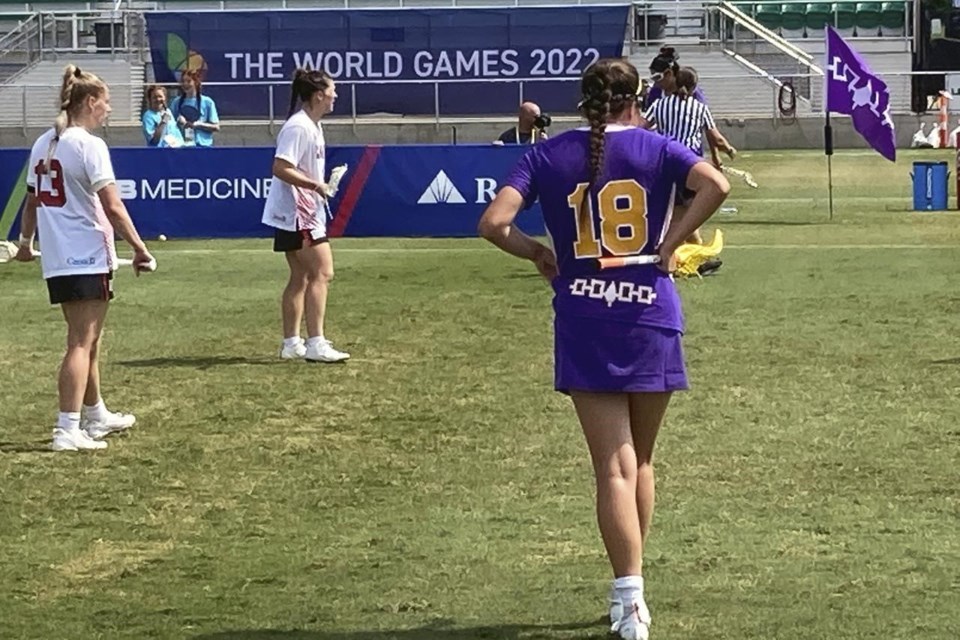One of the first gifts any member of the Onondaga Nation receives is called a “crib stick” — a small lacrosse stick given to babies that symbolizes the importance of that sport to people who invented it.
Nearly 1,000 years after lacrosse was first played on fields that could sometimes stretch for miles across the Haudenosaunee Confederacy, the sport will be on the Olympic schedule in Los Angeles in 2028. Whether players for the Haudenosaunee, a collection of six Indigenous nations whose territory covers upstate New York and adjacent sections of Canada, will be able to suit up in that tournament is a question that will keep the lacrosse world on edge between now and then.
For now, the International Olympic Committee has ruled out having the Haudenosaunee (formerly known as the Iroquois) play as their own team, the way they have at past world championships and last year's World Games. This is because of a rule that only allows teams at the Olympics from countries with a national Olympic committee.
But there are still pathways. A spokesperson for the IOC told The Associated Press it's up to Olympic committees in the U.S. and Canada, in coordination with World Lacrosse, “to decide if they include athletes from Haudenosaunee in their respective teams depending on the passport they hold.”
Leo Nolan, the executive director of the Haudenosaunee national team, said people associated with the team were excited to see their sport — and hopefully, their nation — represented on the world's biggest stage.
“It's a community spirit, not just a sport," Nolan said. "It's an integral part of who we are and what we're about. How many other sports have that kind of wherewithal, something that really has a true meaning? I don't know of many sports that have the same spiritual meaning that this has.”
Working with World Lacrosse, the sport's international federation, organizers for the Los Angeles Olympics leaned heavily into the Indigenous history of the sport to sell the IOC on bringing lacrosse back to the games as a medal event for the first time since 1908.
The story goes back much further than that — to around the year 1100. Tribes In northeastern North America often played games involving more than 100 men on a side. Lacrosse was used to help tribes get ready for wars; it was focal point of social gatherings, a religious experience and also sometimes a diplomatic tool used to settle disputes. As the story goes, Canadian settlers liked what they saw when they first laid eyes on the game. A dentist named George Beers wrote the sport’s first rulebook in 1867.
Established in 1983, the Haudenosaunee national team has been a regular participant at world championships since 1990.
“I got a glimpse of it, and everybody else did, too,” one of the team's founders, Rex Lyons, said in an interview on the team website about the feeling of his people being included in a global competition. “We talked about having our ancestors standing right there beside us, and we said, ‘Look where lacrosse has taken us.'”
In 2014, the Haudenosaunee men's team won its first world bronze medal. Last year, at the Olympic-style World Games, the men's team finished fifth (out of eight) and the women finished seventh.
To compete there, it took a sign-off from the Olympic committees in both the United States and Canada. The team from Ireland sacrificed its own spot to allow the Haudenosaunee to play. The Olympics figure to look different given the IOC's position.
“We know and respect the Olympic charter and the rules that the IOC currently has in place,” said World Lacrosse CEO Jim Scherr. “We'll continue to work with LA '28, the respective Olympic committees and the Haudenosaunee to find a creative solution.”
Sarah Hirshland, the CEO of the U.S. Olympic and Paralympic Committee, said honoring the Haudenosaunee’s role in the sport “is something we look at and say, it’s very cool and exciting.” In a nod to the political realities of the situation, she said “we would want to make sure that everyone feels that the process to get there is very, very fair.”
A spokesperson for the Los Angeles Games said "together, we intend to find creative solutions that honor the sport’s heritage and allow participation for Haudenosaunee athletes, while respecting the Olympic Games framework established by the IOC.”
Nolan said that while the dream is for the Haudenosaunee to play on the world's biggest stage, simply getting lacrosse back into the conversation at the Olympics is a victory of sorts.
“I think there are Olympic people involved who know this is really important, not just for Indigenous communities, but for all of us,” Nolan said. “It's a chance for us to share, more and more, about who we are and what we're all about.”
___
AP Olympics: https://apnews.com/hub/2024-paris-olympic-games
Eddie Pells, The Associated Press


